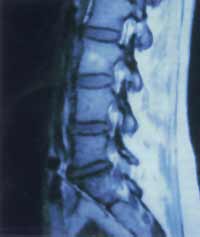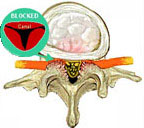Did you know?
If you can answer yes to any of the following questions, you should consult a spine specialist:- Has your low back pain extended down your leg?
- Does your leg pain increase if you lift your knee to your chest or bend over?
- Have you had severe back pain following a recent fall?
- Have you had significant back pain lasting for more than 3 weeks?
- Have you had back pain that becomes worse when you rest, or wakes you up at night?
- Do you have persistent bladder or bowel problems?
Health Facts

Back pain is often caused by obesity
Most people know that obesity contributes to the development of various diseases. However, did you know that obesity is a contributing factor to back pain? It is true. Being overweight or obese can significantly contribute to osteoporosis, osteoarthritis, rheumatoid arthritis, degenerative disc disease, spinal stenosis, and spondylolisthesis.
Symptoms of a Spinal Stenosis
 The congenital form of spinal stenosis is seen in individuals who
are born with a narrow spinal canal. In these individuals, minimal
changes in the structure of the spine can cause severe spinal stenosis.
The congenital form of spinal stenosis is seen in individuals who
are born with a narrow spinal canal. In these individuals, minimal
changes in the structure of the spine can cause severe spinal stenosis.
The more common acquired form of stenosis is caused by progressive
changes in different spinal elements (such as the discs, joints, ligaments,
etc.) As people age, all these different elements sag or bulge and
form arthritis that narrows the spinal canal.
Patients with spinal stenosis complain mainly of leg pain which worsens
with walking. Back pain is also commonly seen with this problem. The
leg pain is often improved with sitting or bending over. Rarely, bowel
or bladder symptoms or progressive weakness can occur; these symptoms
are very severe and necessitate immediate surgery.
Spinal stenosis can be diagnosed with magnetic resonance imaging or
a CT myelogram. Regular X-rays are helpful for evaluating the general
bony structure of the back as well. After diagnosing spinal stenosis,
anti-inflammatory medications, steroids, and narcotics may be prescribed. (For an in depth interview with Dr. Delamarter on Lumbar Spinal Stenosis click here.)
Treatment Options for Spinal Stenosis
Physical therapy and steroid injections into the back may also be helpful in relieving the symptoms of stenosis. Furthermore, specialized nerve or joint blocks can be helpful for diagnosing and treating this problem.Rarely, the above modes of treatment do not improve the patients' leg/back pain. In this case, surgery is an effective means of relieving the pressure on the nerves. Surgery involves the removal of the bony and ligamentous bulges which are placing pressure on the nerves.
Advances in medical technology and new investigative devices may offer new hope.
One such investigational device is coflex® — a dynamic stabilization implant designed to create spinal stability while working to return your spine to a state that more closely resembles its normal physiology.
A clinical research study is currently enrolling patients to evaluate the safety and effectiveness of the coflex device as compared to pedicle screw fixation and spinal fusion. You or someone you know who is suffering from lumbar spinal stenosis may be eligible to participate in the study.
- Medications
- Acupuncture
- Body Braces
- Physical Therapy
Conservative Treatments:
- Spinal Fusion
- Laminectomy
- DYNESYS® Spinal System
Surgical Treatments:
Latest news
Visit our media library for access to all of our news videos.
The Spine Institute is often in the news pioneering new treatments to help the reported 34 million Americans 18 years and older who suffer lower back pain, and another 9 million who suffer neck pain. Watch the news coverage here.

 Spinal stenosis refers to narrowing of the spinal canal which causes pressure on the spinal nerves or cord.
Spinal stenosis refers to narrowing of the spinal canal which causes pressure on the spinal nerves or cord.